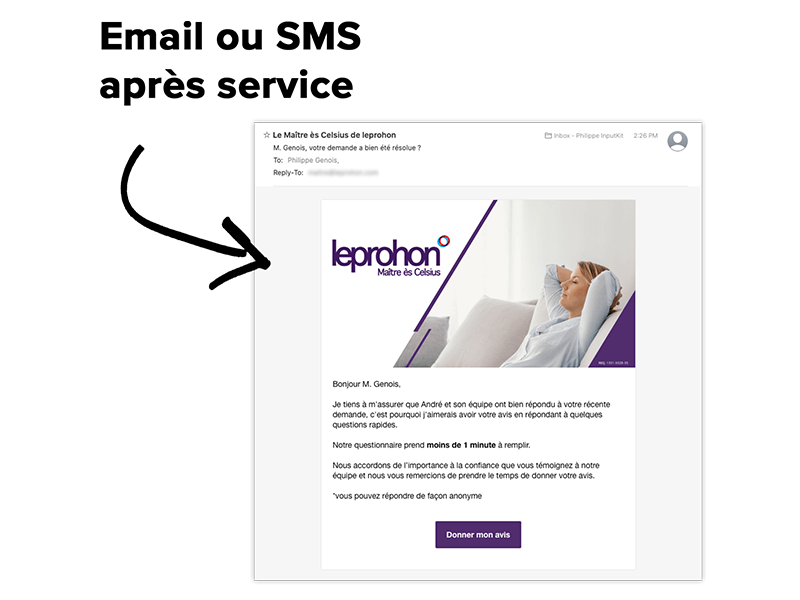Imagine the following scenario: a customer has been saving for a long time to buy the television of their dreams. After several searches on the web and phone calls, they finally found the product they wanted. Good news: it seems to be available in a nearby shop. The customer takes the trouble to go to the store to buy the television, but they are immediately faced with several disappointments.
When they arrive, no employee comes to greet them or advise them about their purchase. Then, when an employee finally notices their presence and comes to see them, the product is not even in inventory. The client asks for explanations, and wants to understand what happened internally, but no staff member gives them more time. They finally left the store, extremely disappointed and dissatisfied with their experience.
Download now: -> How to Track and Optimize Customer Satisfaction [Free French EBook]
Does this story remind you of a similar situation you experienced? To avoid duplicating this situation, discover 11 examples of bad customer experiences and valuable tips to fix them.
What is a bad customer experience?
Defining a bad customer experience
Since a customer experience is defined as the sum of the emotions and perceptions felt during a shopping journey, it can be said that an experience is negative when it results in disappointment compared to the initial expectations. This unpleasant experience can be the result of several factors impacting customer satisfaction. For example, a bad customer experience can be the result of an overly complex shopping journey, poor product quality, bad customer reception, poor customer service, a long phone wait, or even unpleasant interactions with your staff.
Online, there are also several examples of bad customer experiences. A lack of internal communication, combined with numerous telephone transfers, can make customer support unbearable. Similarly, the disproportionate use of chatbots (by never being able to speak to a human) can make access to human contact difficult. These irritants can completely dissuade your customers from doing business with you again!
To avoid following these bad customer experiences, be sure to be proactive in tracking customer satisfaction. A customer who has a great experience in your business will be much more likely to recommend you to their loved ones. Conversely, an unpleasant customer experience will discourage your customers and prospects from doing business with you. It is therefore important to follow up on your customer satisfaction!
The negative impacts of a bad customer experience
While customers are often difficult to attract and retain, they are also very easy to lose. A company offering poor customer service is at high risk of losing the trust of its customers, who will then go to a competitor. This is a typical example of the negative impact of a bad customer experience.
To shed more light on the subject, here are six impacts of a bad customer experience on your business:
- A bad reputation: If your company provides bad customer service, know that it is negative for your brand image. Dissatisfied customers will not hesitate to leave negative reviews online or to use negative word of mouth in order to dissuade your prospects from doing business with you.
- Loss of existing customers: As a result of a bad experience, your customers are unlikely to come back to you. A bad reputation can also make your current customers more suspicious and critical of the quality of your services.
- The difficulty in attracting new leads: Similarly, a bad reputation combined with negative word of mouth will discourage your prospects from doing business with you. This will make acquiring new customers much more difficult and will have a significant impact on your revenue.
- Recruitment difficulties: A poor brand image will have a negative impact on your employees’ motivation. By having a bad reputation, your customers will be more critical of the lived experience. In this sense, your staff members will be discouraged by the lack of recognition of your clientele. In addition, they will be more stressed about working for a brand known for its poor quality experience. In the long term, these factors may generate a high turnover rate and a bad reputation as an employer. This will discourage potential talent from working for your organization.
- A loss of revenue: If your customers are sometimes expensive to acquire and retain, a single bad experience can completely discourage them from returning to your business. With that in mind, you lose all the potential revenue that these customers could have brought you in future transactions. In addition, negative word of mouth will also prevent you from acquiring and retaining potential prospects. This is a great example of the consequences of a bad customer experience!
- Your competitors will steal market share from you: Of course, your dissatisfied customers will not hesitate to replace you in case of need. So, not only will you lose some revenue, but your competitors will not hesitate to seize this opportunity!
A bad customer experience can have a significant impact on your business. In this sense, take care to regularly question your customers using personalized satisfaction surveys. This will allow you to implement an unforgettable customer experience adapted to the concrete needs of your customers. This is a must for the success of your company!
What are the typical causes of bad customer experiences?
Examples of bad customer experiences
As previously discussed, poor customer service will have many negative impacts on your customer satisfaction. In fact, a single bad experience can completely ruin the success of your business: loss of customers and prospects, lower revenues, high turnover, poor reputation… The list is long!
How can you offer an exceptional service? Above all, by drawing inspiration from the worst practices, you will know what not to do if you want to be successful! To help you, here are eleven examples of bad customer experiences to avoid.
1. A lack of internal communication prompts the client to constantly explain an experienced problem
A bad customer experience can happen during a simple phone call.
A customer contacts your customer support to learn more about a product. Not knowing the answer, your employee transfers them to another department. When finally answered, after several minutes of waiting, they are told that they must repeat the reason for their call before being transferred back to another employee. After several transfers, waiting delays and repetitions of their situation, the client is completely discouraged. They decided to end the call and not do business with the company. This is a perfect example of a company with poor customer service, isn’t it?
Your customers expect staff to be able to meet their expectations. To this end, they must be able to inform clients according to their needs and to communicate with their colleagues internally if necessary. However, these numerous transfers show a blatant lack of internal communication.
To avoid this, set up an internal chat to facilitate communication between your employees. Set up frequent meetings and training between your various teams so they can get an overview of your customers’ needs. This way, they can better meet your customers’ expectations while offering exceptional support.
2. Negative interactions with existing staff
When it comes to customer service, it is important to maintain a professional behavior, especially when it comes to customer dissatisfaction.
Imagine: a customer is trying to find out from one of your team members. Your employee only answers them after several attempts to finally tell them that they don’t have the answer to their questions. However, instead of asking their colleagues, they stay with the client without taking action. This lack of responsiveness irritates the customer: they start to complain when the employee raises their voice and refuses to assign them any service. Discouraged by this bad reception and the rudeness of the employee, the client decides to leave the premises. This is a clear example of a bad customer experience!
In order to provide adequate service, encourage your employees to improve their customer service skills. Encourage them to use a calm and professional tone at all times. Promote a positive attitude and proactive resolution of customer dissatisfaction. Finally, encourage them to keep smiling to encourage good interactions with your customers. This will have a positive impact on your customer experience!
3. A lack of empathy for the customer’s reality
Empathy is a necessary skill to provide a good customer experience. As a result, a lack of empathy can be reflected in several examples of bad customer experiences:
- An employee who is extremely rigid about the measures in place refuses to be flexible or to inquire about a client’s requests;
- An employee ignores complaints from an dissatisfied customer as a result of poor service;
- A company that changes key aspects of its customer journey without bothering to inform its customers.

These examples of bad customer experiences can quickly turn into irritants for your customers. They will feel ignored and will be led to believe that their problem is not being considered. To this end, your dissatisfied customers will not hesitate to publicly share their bad experience in order to be heard by the company. This is a significant impact of poor management of your client relationships.
In this sense, following a bad experience, take care to apologize to your customers. By showing them that their well-being is at the center of your priorities through an empathetic approach, you may be able to rectify the situation!
4. A refusal to adhere to a client’s requests without any explanation
Imagine the following scenario: a customer receives a discount coupon for a specific product sold at a branch one hour from home. They call to make sure the in-store discount is valid. Once the employee confirms the coupon’s compliance on the phone, the customer finally decides to go there to buy the product in question.
When they arrive there, the staff refuse to give them the discount requested. The client asks for an explanation for this contradictory decision: however, the employees do not provide any answers. Their rigidity discourages customers who, dissatisfied, leave the store empty-handed.
This bad customer experience is bad for your business. Such customer service management shows your customers that you lack transparency and flexibility, combined with an obvious lack of internal communication.
To avoid such a situation, encourage your employees to answer your customers’ questions. This initiative will help you build trust with your customers and optimize the management of your customer relationship!
5. Acting without taking into account the presence of the customer
A great example of a bad customer experience is a complete lack of service within your company.
 Take for example a fast food service. A customer arrives at the restaurant: however, no employee bothers to welcome them. In a hurry, the client tries to attract the attention of the staff; however, they are too busy discussing among themselves to greet them or even offer them an adequate service. Following such an experience, the customer will certainly not return to your restaurant!
Take for example a fast food service. A customer arrives at the restaurant: however, no employee bothers to welcome them. In a hurry, the client tries to attract the attention of the staff; however, they are too busy discussing among themselves to greet them or even offer them an adequate service. Following such an experience, the customer will certainly not return to your restaurant!
No one likes to be ignored and left alone in a customer experience. To this end, make your staff aware of the importance of good customer service. Hiring and training professional staff will definitely benefit your customer experience!
6. Failing to meet deadlines
Did you know that additional delays are one of the main causes of customer dissatisfaction? Indeed, according to Small Business Trends, 95% of customers would be willing to pay more to get a delivery the day of the purchase. According to the same source, only 46% of customers get the delivery time they want.
Whether it’s a delivery service or a B-to-B deliverable, be transparent about the expected timelines. A company with impossible deadlines will offer a bad customer experience. This company will inevitably lose the trust of its customers and dissuade them from doing business with it again in the future.
To avoid customer dissatisfaction, offer reasonable deadlines to your customers. You could even give a longer delivery time than originally planned in order to have more flexibility in the event of unforeseen events. This way, you can impress your customers by offering them faster than expected deadlines! 
7. Offer a product that does not meet initial expectations
A customer deals with your company to meet a specific need. In addition, if they buy an obsolete product whose use does not match the description, they are at high risk of filing a complaint with your company. Similarly, a product that breaks just a week after its first use may discourage your customers from returning to your organization for future services.
Indeed, 40% of customer dissatisfactions come from a product or service that does not correspond to a customer’s initial expectations. To avoid repeating such a bad customer experience, analyze the concrete needs of your customers in order to offer them exceptional and personalized service that will meet their expectations.

8. Waiting too long to get customer support
It is quite common to find that some companies offer too long waiting times to get support.
A customer needs immediate support. They call the company for help. However, due to a volume of calls that is too high for the number of employees available, they are put on hold for several minutes or even hours.
According to Coder Mag’s study, 41% of customer dissatisfactions are caused by a lack of availability on the part of staff. In this sense, make sure you have a team entirely dedicated to customer support in order to minimize the waiting time. This is a must for the success of your company!
9. Censoring or ignoring negative comments
A perfect example of a bad management of your customer experience is the removal of your online negative reviews. This practice prohibited by Google can result in heavy penalties for your company: this can significantly reduce your visibility on search engines, which in turn will reduce your acquisition of new customers.
In addition, censoring your bad comments will not solve customer dissatisfaction. On the contrary, this practice will cause your dissatisfied customers to express themselves publicly on other platforms in order to be heard by your company. In this sense, ignoring your negative reviews will give you a bad brand image, in addition to deterring your prospects from doing business with you.
According to the study conducted by Stratégies, 47% of Internet users are suspicious of companies that only have positive online reviews. To this end, a few negative reviews prove to your prospects that you are being transparent and actively try to resolve customer dissatisfactions. It is important to respond to customer reviews rather than censor them!
10. An unpleasant environment
A customer goes to a store to make a purchase. However, as soon as he sets foot in the branch, he realizes that the state of affairs leaves something to be desired.
The floor is dirty and sticky, the shelves are cluttered with products stacked in a hazardous way. There is little space to move and the customer journey does not seem defined, which makes navigation difficult. This is a blatant example of a bad customer experience.
To avoid this type of inconvenience, create a safe and clean environment for your customers. Define what type of product is in each aisle to make the journey easier for your customers. Finally, clean your store regularly according to the best sanitary practices. This is a must to attract customers to your points of sale!
11. Not taking the time to question your clients after an experience
You try to offer a quality service to your customers. Yet they regularly complain about your staff and never come back to your company. Instead of asking them why they are unhappy, you continue to offer them the same poor quality service. No changes are made to better satisfy your customers. Discouraged, they eventually turn to your competitors.
This bad customer experience demonstrates the importance of sending satisfaction surveys to your customers on a regular basis. These surveys are a gold mine of information: they will allow you to improve your experience according to the concrete needs of your customers. This is a crucial asset for the success of your business.

What to do if a bad customer experience is reported to you?

Your company aims to provide a successful customer experience to ensure customer satisfaction. However, a dissatisfied customer may complain about your services.
How do I react to this situation? Here are seven easy steps to help you:
- Apologize to the dissatisfied customer;
- Let the customer express themselves to better understand the situation;
- Validate their emotions and acknowledge their problem;
- Propose relevant solutions related to the problem addressed (full refund, free product, extended warranty, etc.);
- Share the report with your team to hold them accountable for the bad experience;
- Follow up with the customer to ensure their satisfaction with the proposed solutions;
- Thank the customer for the report and assure them that their feedback will be considered to improve your customer experience.
How can InputKit help you deliver a great customer experience?
Do you want to give your customers a unique experience? If so, InputKit is the solution for you!
Our customer experience assessment and improvement solution allows you to send customer satisfaction surveys at the right time, one to two hours after the experience. Plus, with our 49% email and 57% SMS response rates, you can gather valuable insights to improve your customer experience. With these fully customized and automated surveys, you can find some flaws in your customer journey to avoid a bad customer experience. In addition, these surveys even allow you to automatically invite your satisfied customers to leave you a positive review online in order to improve your e-reputation. Interesting, isn’t it?
In addition, our solution is equipped with artificial intelligence (AI). To this end, you can adapt your surveys to the experience of your clients. This feature will allow you to establish a human connection with your customers while saving valuable management hours. This is a must to focus your efforts on designing an unforgettable customer experience! With our solution, you will certainly avoid any example of bad customer experiences.

Finally, did you know that our employee performance measurement solution also contributes to your customer experience? With this feature, you can share positive feedback from satisfied customers with your staff to better motivate and empower them at work.
By seeing the real impact of their service on the lives of their customers, your employees will be motivated to give the best of themselves to offer an unforgettable experience. By reading the feedback from their customers, they can continuously improve while putting their expertise to the benefit of your company.
Avoid following bad customer experience examples: build an organizational culture based on trust and mutual respect to encourage your employees to perform at their best. This is a great way to increase your staff’s engagement while creating a memorable customer experience.
Schedule my free InputKit demo now to improve my customer experience
To ensure the success of your business, keep in mind our examples of bad customer experiences and make sure you avoid them!
Provide your employees with relevant job-related training and implement an internal chat system to optimize your customer support. Afterward, encourage your employees to keep a calm and professional tone throughout their interactions with your customers. Leverage flexibility and empathy to deliver quality service that lets your customers know they are at the center of your priorities. In addition, keep your branches clean and tidy to provide your customers with a space conducive to your services.
When additional delays occur, offer quick support to minimize customer dissatisfaction. Finally, after the experience, take the time to read your reviews online and send satisfaction surveys to correct some flaws in your customer journey. These are good practices to follow to avoid a bad customer experience.
Do you want to improve your company’s customer experience? If so, feel free to schedule a free, fully customized demo of our InputKit solution. Our team of subject matter experts will be happy to help!
FREE FRENCH GUIDE
Why and how to monitor customer satisfaction? All about customer satisfaction and the Net Promoter Score!



Related articles

Receive our best articles and tips by email
Be the first to know about our new articles.





